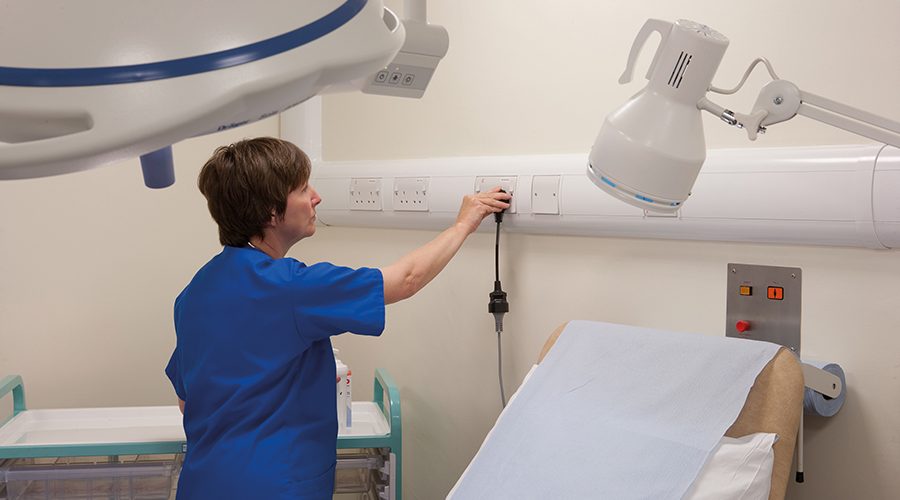Here, Nick Hayler, Technical and Product QA Manager at Marshall-Tufflex, discusses the benefits of antimicrobial cable management solutions, and how the innovative technology can help prevent the spread of HCAIs.
Marshall-Tufflex
For specifiers working within the healthcare sector, infection control is something that should be considered as a priority when working on either a renovation or new build project.
Healthcare associated infections, or HCAIs, are infections that occur within a healthcare setting that were not present in a patient before entering. Certain microbial organisms can proliferate to cause infection and disease, therefore those working in the sector need to manage the threat of infection where it is of most importance, such as hospitals, surgeries, nursing or care homes and health centres. With many of the patients using these facilities already vulnerable to further illness, any infections could pose a serious danger.
Antimicrobial solutions
Individuals in healthcare facilities – both staff and patients – will be constantly touching and coming into contact with all areas of the building and could potentially be exchanging harmful bacteria. It is therefore crucial for any healthcare facility to adopt methods of combating this – reducing the risk of an HCAI outbreak.
Whilst it is commonly accepted that these institutions should be rigorously cleaned, specifying materials with antimicrobial properties within the build or fit-out will also contribute significantly to infection control; and there are now a wide range of materials available, from door handles, to paint – and also trunking and cable management systems.
As a building’s cable management solution will constantly come into contact with a multitude of people, it has the potential to become a breeding ground for bacteria if not managed correctly. Therefore, it is sensible to specify cable management solutions that take this into account.
An innovation in antimicrobial technology
In order to fight bacteria, antimicrobial cable management systems are silver formulated. This technology works by disrupting the key cell functions of bacteria and preventing them from reproducing – subsequently killing them due to their short lifespans – as the silver ions activate when in contact with moisture in the air.
By incorporating silver ions within the PVC-U or ABS based material, perimeter trunking will deliver ongoing antimicrobial protection that prevents 99.9% of harmful bacteria from surviving on its surface. It is the most effective weapon in the battle against superbugs and cross-infection when used in conjunction with meticulous cleaning and personal hygiene routines.
It is important to note to always check the product, as silver ion antimicrobial systems must be registered with the Environmental Protection Agency, and compliant with the European Biocidal Products Directive. In addition, when specifying this type of product, Part M of the UK Building Regulations for Visual Impairment must also be adhered to – requiring face plates to differ in colour from their background.
Antimicrobial trunking and other building systems come in two basic variants, one is with the silver ion formation added to the PVC-U integrally when it is manufactured, and the other where it is applied to the surface during post production. It is best practice to specify products where the bio solution is integral to the PVC-U material as it is far more effective and reliable. In many high-traffic healthcare environments, it is common for trunking to be scratched or damaged over time, and if these products are simply coated with the silver ion formation on the surface, this will leave gaps where bacteria can fester and multiply. With an integral approach, even when damage occurs there is still protection against HCAIs.
When specifying trunking solutions, it is also advisable to take into account the cleaning of the product. The trunking should be as smooth and curved as possible, allowing for them to be easily wiped down, and with little or no crevices and corners. Not only does this ensure an efficient cleaning process, it provides peace of mind that no area has been missed – which could leave a potential breeding ground for bacteria.
Dedication to fighting bacteria
Marshall-Tufflex, a leading manufacturer of cable management solutions, has many years of experience in this area, having been developing antimicrobial technology in whole cable management systems for medical and healthcare environments since 2008. We offer two systems as part of our standard range that contain the technology depending on the aesthetic requirements of the building; Odyssey and Sterling Curve Profile 1. All our materials are tested and re-certified annually by an independent third party, to insure premium quality and efficiency that is essential in such sensitive environments.
Odyssey Bio is a curved dado trunking with one main compartment and two smaller compartments designed for heavy traffic areas such as hospitals – and the only solution on the market with a fully curved profile. This is perfect for healthcare environments which need to be cleaned regularly, making them easy to wipe down and prohibiting surface clutter. Sterling Curve Profile 1 is a sleek, medium-sized dado trunking system with three segregated compartments. Whilst not offering the complete full curvature of Odyssey, Sterling still has curved compartments designed to stop clutter, avoid dust traps and make cleaning easy.
HCAIs pose one of the most serious threats in healthcare institutions, and, if possible, it is crucial to always specify materials and products that can help prevent against harmful bacteria. Therefore, selecting the best antimicrobial products available – alongside regular and thorough cleaning – is essential. Patients in these environments are vulnerable and need the best care possible, sometimes in the areas least expected.









